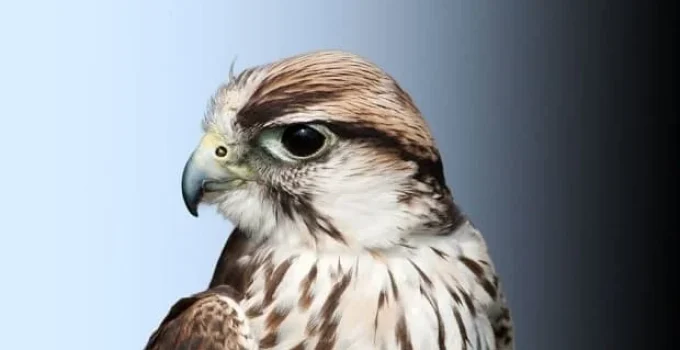Yes, falcons can see in color, and their color vision is more advanced than that of humans. Like many birds of prey, falcons possess tetrachromatic vision, meaning they can perceive four color channels—including ultraviolet light, which humans cannot detect. This heightened color perception plays a critical role in their ability to hunt, navigate, and identify mates.
🔍Dive Deeper
- How Falcon Vision Works
- Color Perception: More Than Meets the Eye
- The Role of Ultraviolet Vision
- Hunting with Color Cues
- How Falcon Eyes Compare to Humans
- 🎯 Final Thoughts
- 📚 References
How Falcon Vision Works
Falcons, like most birds, have a highly specialized retina packed with cone cells—the type of photoreceptors responsible for detecting color.
| Falcon Eye Features | Description |
|---|---|
| Cone cell types | 4 (tetrachromatic) |
| Visual acuity | 2–3× sharper than humans |
| Foveae (focus points) | Two per eye (binocular & monocular vision) |
| UV light detection | Yes, fourth cone cell is UV-sensitive |
The dual foveae allow falcons to switch between scanning wide areas and focusing tightly on prey. Their high cone density gives them remarkable detail and color perception, essential for locating moving animals against complex backgrounds.
Color Perception: More Than Meets the Eye
While humans are trichromatic (seeing red, green, and blue), falcons are tetrachromatic, with the added ability to see ultraviolet (UV) wavelengths. This allows them to:
- Differentiate subtle plumage colors in other birds.
- Detect trails or markings left by prey (like urine or feathers that reflect UV light).
- Navigate by using UV patterns in the sky or terrain.
🧪 Scientific Insight: A 2011 study published in Vision Research found that raptors like falcons have retinal oil droplets that act as filters, sharpening their color discrimination abilities [1].
The Role of Ultraviolet Vision
Ultraviolet perception isn’t just for show—it serves practical, survival-related functions:
- Tracking prey: Many small mammals leave UV-reflective urine trails, making them easier to locate.
- Mate selection: Plumage in birds often reflects UV light, signaling health or maturity.
- Territorial awareness: UV markings in feathers or droppings can communicate dominance.
| 📊 According to a study in Nature, birds with UV sensitivity are better at locating cryptic prey that would otherwise blend into the environment [2]. |
Hunting with Color Cues
When a falcon is searching for prey, color cues become essential. In open environments like grasslands or cliffs, being able to detect slight changes in color—especially UV-reflective materials—allows them to:
- Pinpoint rodents that blend into the ground.
- Spot other birds from afar, even if they’re camouflaged.
- Identify human-made hazards like reflective glass or wires.
Peregrine Falcons in urban areas, for example, may use visual contrast from pigeons or starlings to target them mid-flight, depending in part on color perception and movement tracking.
How Falcon Eyes Compare to Humans
Here’s a direct comparison of falcon and human vision:
| Feature | Falcons | Humans |
|---|---|---|
| Color detection | Tetrachromatic (4 types) | Trichromatic (3 types) |
| UV light detection | Yes | No |
| Visual acuity | ~2.6x sharper | Baseline |
| Field of view | ~300 degrees | ~180 degrees |
Their superior acuity and color range give falcons a massive advantage in locating and locking onto prey. What looks like dull brush to us may appear vibrant and information-rich to a falcon.
🎯 Final Thoughts
So, can falcons see in color? Absolutely—and more vividly than we can imagine. Falcons perceive not only the visible spectrum but also ultraviolet light, giving them an enhanced sense of detail, motion, and contrast. This superior vision helps them hunt, choose mates, and survive in diverse environments. Their eyesight is not only sharper than ours—it’s a key to their status as elite aerial predators.
📚 References
- Lind, O., Mitkus, M., Olsson, P., & Kelber, A. (2011). “Ultraviolet sensitivity and color vision in raptors.” Vision Research, 51(7), 726–731. Link
- Hausmann, F., Arnold, K. E., Marshall, N. J., & Owens, I. P. F. (2003). “Ultraviolet signals in birds are special.” Nature, 426(6965), 125–126. Link
- Potier, S., Duriez, O., & Bonadonna, F. (2018). “Visual adaptations in birds of prey.” Current Zoology, 64(4), 421–437. Link
- National Audubon Society. “Bird Vision and UV Light.” Link
- Martin, G. R. (2017). The Sensory Ecology of Birds. Oxford University Press.
